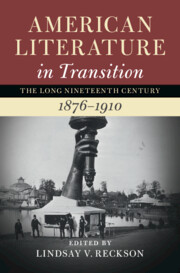Book contents
- American Literature in Transition, 1876–1910
- Nineteenth-Century American Literature in Transition
- American Literature in Transition, 1876–1910
- Copyright page
- Contents
- Contributors
- Series Preface
- Acknowledgments
- Chronology
- Introduction
- Part I Transitive States
- Part II Post-Reconstruction Aesthetics
- Chapter 6 Lyrics of the Color Line
- Chapter 7 Experimental Realisms
- Chapter 8 Species of Sentiment
- Chapter 9 The Microclimates of Regionalism
- Chapter 10 Racial Topographies and the Poetics of Mass Culture
- Part III Old Materialisms
- Part IV Immanent Techniques
- Index
Chapter 10 - Racial Topographies and the Poetics of Mass Culture
from Part II - Post-Reconstruction Aesthetics
Published online by Cambridge University Press: 24 August 2022
- American Literature in Transition, 1876–1910
- Nineteenth-Century American Literature in Transition
- American Literature in Transition, 1876–1910
- Copyright page
- Contents
- Contributors
- Series Preface
- Acknowledgments
- Chronology
- Introduction
- Part I Transitive States
- Part II Post-Reconstruction Aesthetics
- Chapter 6 Lyrics of the Color Line
- Chapter 7 Experimental Realisms
- Chapter 8 Species of Sentiment
- Chapter 9 The Microclimates of Regionalism
- Chapter 10 Racial Topographies and the Poetics of Mass Culture
- Part III Old Materialisms
- Part IV Immanent Techniques
- Index
Summary
In January 1870, Sarah M. B. Piatt published a seemingly simple poem, “A Child’s First Sight of Snow,” in The Galaxy, an illustrated, monthly “magazine of entertaining reading”:
- Oh, come and look at his blue, sweet eyes,
- As, through the window, they glance around
- And see the glittering white surprise
- The Night has laid on the ground!
- This beautiful Mystery you have seen,
- So new to your life and to mine so old,
- Little wordless Questioner – “What does it mean?”
- Why, it means, I fear, that the world is cold.
- Type
- Chapter
- Information
- American Literature in Transition, 1876–1910 , pp. 198 - 212Publisher: Cambridge University PressPrint publication year: 2022



